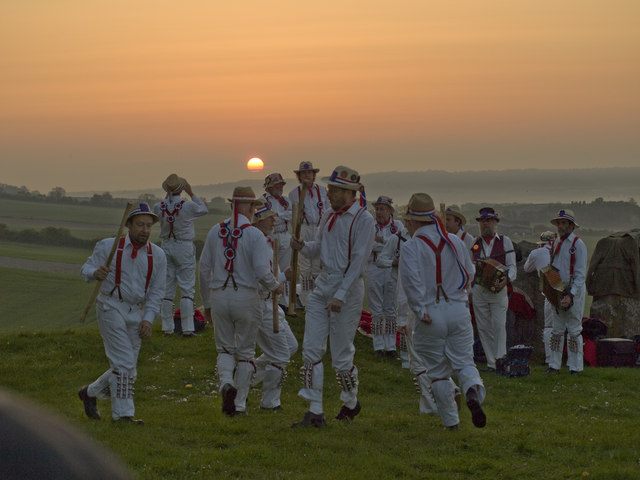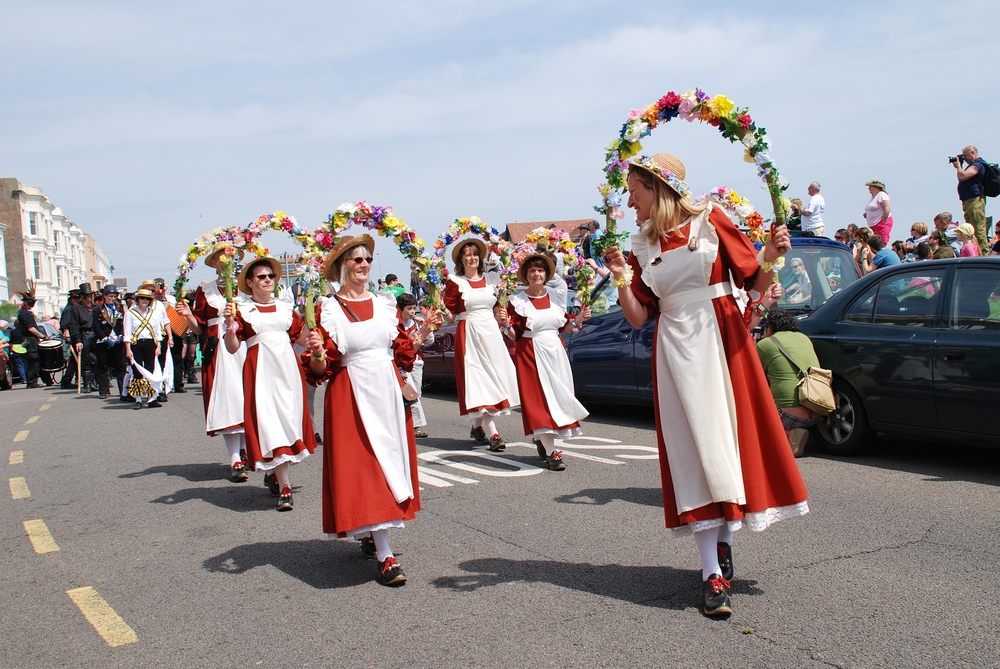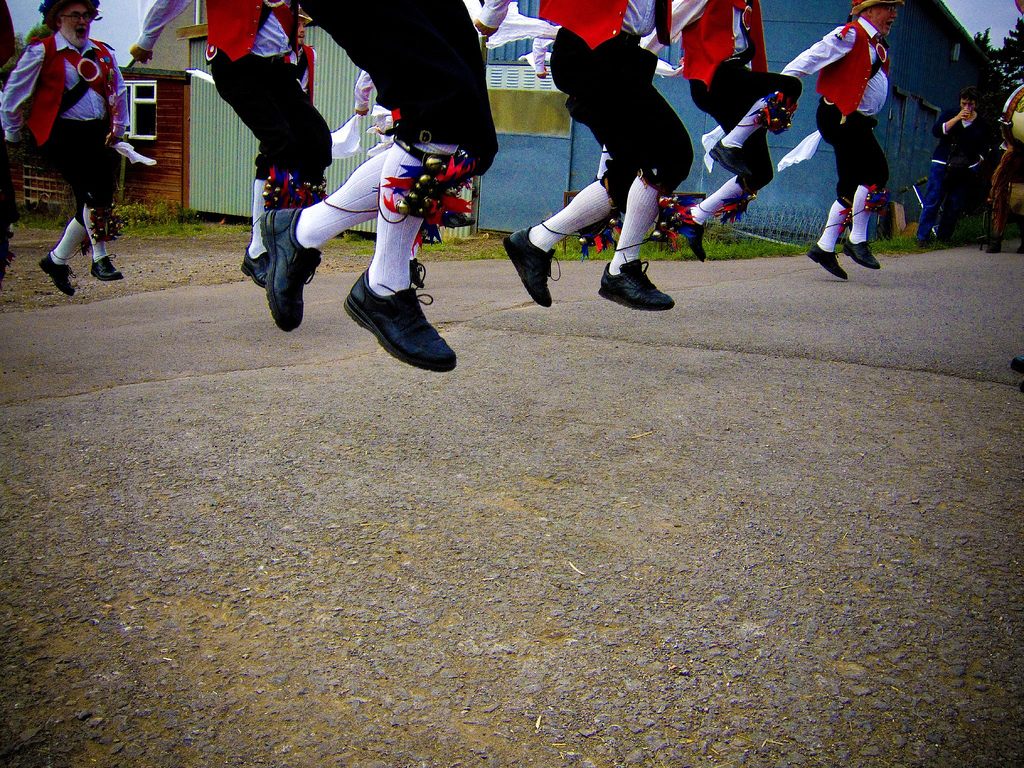The Hopping, Skipping, Handkerchief-Waving Mayhem of Morris Dance
The traditional English folk dance is adapting to the 21st century.

Morris dancers at sunrise in Kent, England. (Photo: Simon Knights/CC BY-SA 2.0)
A gathering of men begins to play accordions. Some also sing. Their companions, dressed in white, with bells around their knees and black hats adorned with flowers atop their heads, begin to dance. They wave white handkerchiefs as they skip and hop in time with the music, the jangling of the bells adding to the celebratory mood.
This is traditional Morris Dancing. A popular fixture at country fairs around England, the folk dance is centuries old. But there are some interesting changes afoot within the Morris community as the tradition has adapted to remain relevant in modern times. Among those changes: the inclusion of women, the adoption of Steampunk aesthetics, and the blasting of Guns ’n’ Roses.

Morris dancers in Jersey. (Photo: Danrok/CC BY-SA 2.0)
According to the Morris Ring, one of three English national federations for the dance style, Morris Dance has existed in some form in England for at least six hundred years, possibly longer. Historical records indicate it being performed in the court of Henry VII in 1500.
While it bears some similarities to traditional Catalan and Basque dances, Morris has developed its own distinct forms and variations. Cotswold Morris is the most instantly recognizable, performed by a side (a dance group is called a side) of six men, accompanied by a musician and a fool. Dressed in white, they perform stick and handkerchief dances.
Welsh Border Morris sees men dressed in dark rags, bright ribbons, hats, and blackened faces using sticks for a very vigorous dance. The blackened faces feature in several forms but should not be confused with vaudeville-style blackface; the face painting is intended to make each dancer anonymous. In East Anglia, Molly Dancing, also performed with blackened faces, involves local workers donning women’s clothes as a further means of hiding their identity, while they dance, drink, and generally have a raucous time in public.
Other styles include Rapper-Sword and Longsword (the latter finishing with a complex lock of interwoven swords), and North West Morris (also including the use of clogs). The Rush-Bearing style, in which the dance is accompanied by an elaborate cart, commemorates the “changing of the rushes,” the traditional practice of collecting rushes and laying them on earthen church floors.
Maintaining the Morris traditions has been something of a challenge since the early 20th century. North West rush-carts fell into decline after the Industrial Revolution, and Molly Dancing died out in the 1930s, in part due to changes in agricultural practices. No Welsh Border Sides survived past World War II. While there are a few Cotswold sides still in existence that date back to the 1800s, most are much more recent. Some revival groups formed after each World War, but there was a large resurgence in interest in the 1970s as folk music regained popularity.

Morris Dancing in Hastings. (Photo: Public Domain)
In 2014, the three national Morris organizations held a State of the Morris census. The results showed a huge increase in new sides during the 1970s and ’80s, followed by a slow ongoing decline. Cotswold Morris remains the most popular style by far, followed by Border Style. Perhaps the most notable development is the large number of mixed-gender sides now in existence. Morris was traditionally a men’s dance, and some of the early women dancers recall angry rival male groups disrupting their practices in the ‘70s. Although some groups are still open only to men, woman are no longer a rare sight in the world of Morris.

Members of the Copperfield Clogs morris dancing team perform in Hastings. (Photo: David Fowler/Shutterstock.com)
The inclusion of women has helped to slow the rates of decline. John Melville of the Morris Ring notes that a significant number of dancers from the ’70s revival are giving up because of age. They are not being replaced at the same rates. “The number of teams performing is generally shrinking,” he says, “and the average number of members per team is dwindling.” He also notes that new teams being formed tend to adopt the simpler dance styles and seem to prefer the costumes rather than learning steps, but “they appear to have a really good time, and Morris is better for it.”
Melanie Barber, President of the Morris Foundation agrees: “I think it’s true to say that all teams see a fluctuation in membership over the years. However, the two North West Morris Sides I dance with have both gained younger members recently, and I have seen an increase in the number of young people dancing generally, especially in Cotswold and Clog Stepping, which is really encouraging.”

Morris dancers leaping into the air. (Photo: Steve Cox/CC BY-ND 2.0)
One eager new female dancer is Cathy Brown. She joined Shrewsbury Morris four years ago as a more enjoyable alternative to the gym. Although much of what the group does is rooted in the Border tradition, many of their dances and the accompanying music are written by team members, a move Brown sees as “building on and enhancing the tradition.”
Another group that remains respectful of the Morris traditions but has added an unusual modern twist is Steampunk Morris, based in Kent. This Border-style group still uses the traditional musical accompaniments and the wooden stick routines, but they wear Steampunk costumes and perform a more eclectic set that includes such rock classics as “Sweet Child of Mine” by Guns’n’Roses and Queen’s “We Will Rock You.” Members say that the group has been welcomed by even the most traditional Morris sides, many of whom appreciate that the diversity they bring helps to expand the dance’s reach to younger audiences.
So if the ribbons and sticks can now be accompanied by the guitar solos of Slash, has Morris Dance entered the realms of counter-culture? Absolutely. As Brown tells her teenage sons, “Morris is an alternative subculture, with its own clothes and music, just like punk or goth.”











Follow us on Twitter to get the latest on the world's hidden wonders.
Like us on Facebook to get the latest on the world's hidden wonders.
Follow us on Twitter Like us on Facebook